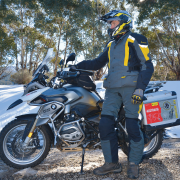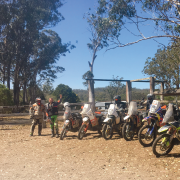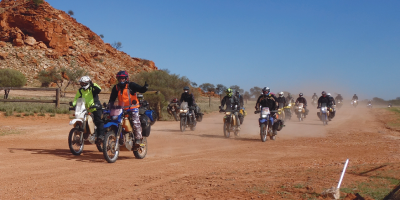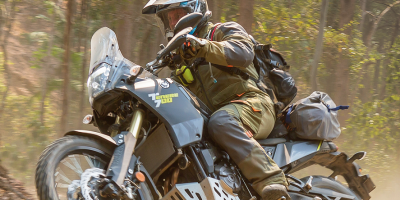Some riders of course prefer to ride in relative silence.
Ever since our ancestors clambered through the e quarters from branch to branch or tree to tree. Then further afield, from grove to grove. The voices became louder to cater
for the longer distances. All the surrounding primates knew your business, whether you needed to bring home nuts and berries at the end of the day and why were you talking to the ranga at the bottom of the gully.
As we became wiser and left the safety of the trees, we stopped grunting loudly over distances and started the thumping of drums and trees to alert our friends and neighbours. This eventually evolved to the spoken word and language, where I’m sure there would have been some that looked in the direction noise, bewildered, thinking, “I didn’t understand a word of that”.
Later, when we only wanted to direct the conversation to one or a few people, we started using semaphore and morse code. This worked well, however, there was still the odd grammar nazi that complained that the sender did not know the difference between there, they’re and their.
“ With human evolution came the evolution of communication devices for motorcycles. These devices are there to keep us safe, well informed and entertained. ”
These forms of communication worked well in their uses but are cumbersome for the motorcyclist. Yelling through the helmet is very muffled, morse code via the headlight of the bike distracts you from watching the road, and reading semaphore via the revision mirror creates spelling mistakes.
Thank God that over the millennia, man has evolved from riding tree branches down hillsides to get his adrenaline fix to riding motorcycles down hills, motor- ways, and dirt roads. With human evolution came the evolution of communication devices for motorcycles.
These devices are there to keep us safe, well informed and entertained. Some riders like to chat all the time, some like to keep their fellow riders informed of road conditions and obstacles. Others like to ensure all the riders in the group are OK mentally, physically and mechanically. Having the device attached to your body at all times in the case you do come off the bike, means you don’t need to crawl the 15 metres to the resting
place of your bike to inform the rest of the riders that you are having a little lay down. Instead, it allows them to hear the Wilhelm scream in real time.
There are numerous devices on the market that can be used for motorcycle communications. 2-way radios can be used due to their low expense, relatively good range and can be used between motorcycle and support vehicle if one being used. Though they are not always waterproof, they do have a listed range of up to 10 km depending on the surrounding topography but you more than likely to get 2 or 3km range. Third party kits are available to attach a microphone and speaker mounted in the helmet while the 2 way radio is attached to your hip. Working on the UHF CB (Citizen Band) frequencies, they will communicate to other devices on the same channels and do not need a license from the ACMA to use them. Charging is generally via a 240v outlet or the 12v from the cigarette plug. These are generally asynchronous, and you need press a button on the device to speak. This can be awkward while riding. The can Prices range from $150 upwards and can be.
Bluetooth intercoms are more affordable than Mesh, easy to set up and have a relatively short range roughly 400 to 600m.
Mesh intercoms can cater for 2 to 15 participants, has a larger range roughly 1 to 2Km. Mesh links all devices together so they communicate and give a wider network coverage as opposed to the redundant daisy chain method of sending signals that worked on a hierarchical system. In layman terms, Bluetooth is like using coax cable and token ring instead of Cat 5 and ethernet.
Mobile phones on their own can be used but again, you need to stop the bike to look at the screen before pressing buttons to make the call and the wrong person gets the Wilhelm scream. If you are out of mobile coverage, this will also hinder your communications.
With motorcycle intercom systems, the two technologies currently used are Bluetooth and Mesh. Both have their merits and need to be considered when selecting which technology and device best suit your needs.
As always, determine what uses and how often the communication device will be used. Consider the price, audio quality, communication range and number of participants – 2 or 10. Make sure you can find the buttons with your gloves on. Ensure it is waterproof and has ample battery life / talk time that will cover your ride as well as the ease of recharging. Also consider additional features such as on-air software updates, handsfree functions, voice assist, GPS, and for light entertainment, a radio. Depending on who you ride with, don’t forget to ensure everyone’s devices are compatible so you are not sitting at a service station for half an hour trying to connect everyone up just after spending half an hour showing everyone how good your new intercom device is.
The two main contenders for intercom units are Cardo and Sena. Both have several products available using Bluetooth and Mesh.
As an example, Cardo Spirit Single retails for $179:00.
It will connect 2 riders using Bluetooth technology at a range of 400m. Most riders travel closer than that. It is waterproof, will connect to any Bluetooth headset, and has voice control for your phone and GPS.
Sena has the Spider RT 1 Single pack retailing at $345:00
It will connect up to 24 riders to a range of 8km with riders 1.6 Km apart – not a bad range for a large group. It will connect to your smartphone and utilize the phone’s Bluetooth to access your music, GPS and phone calls.
On the grander spectrum for those travelling to more remote places and want to keep those at home informed of your progress, safety and well-being, there are a range of communication satellite devices on the market. These do require connection plans and are cheaper than a sat phone. They use the Iridium Satellite network when out of mobile coverage. It works by being paired with your mobile phone and allows you to send messages to anyone with a mobile phone or email address. It also has a panic button if yoU need emergency assistance.
Now when you see a buffalo in a corn field, you can tellyour riding mates. We have come a long way with the advances in technology and communicating, I just hope AI does not come into these devices and start transmitting my thoughts while riding.


















Comments